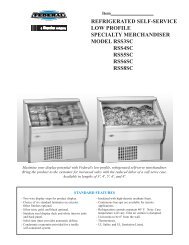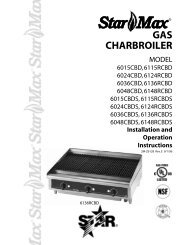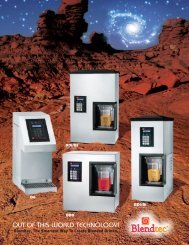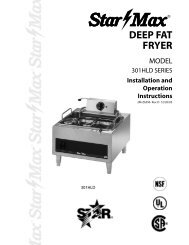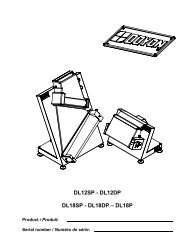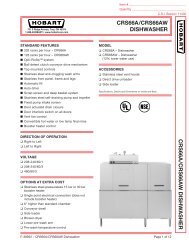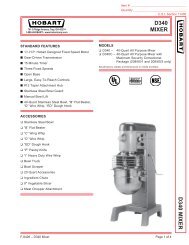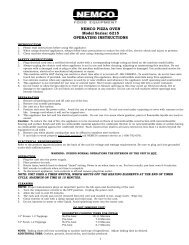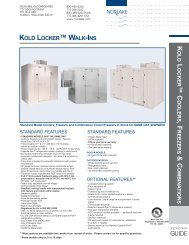- Page 2:
Safety NoticesAs you work on a Q-Se
- Page 5 and 6:
Table of ContentsSection 1General I
- Page 7 and 8:
HEALTH, SAFETY & THE ENVIRONMENTImp
- Page 9 and 10:
Table of Contents (continued)Sectio
- Page 11 and 12:
Section 1General InformationModel N
- Page 13 and 14:
Section 1General InformationWarrant
- Page 15 and 16:
Section 2Installation InstructionsG
- Page 17 and 18:
Section 2Installation InstructionsQ
- Page 19 and 20:
Section 2Installation InstructionsL
- Page 21 and 22:
Section 2Installation InstructionsE
- Page 23 and 24:
Section 2Installation InstructionsS
- Page 25 and 26:
Section 2Installation InstructionsW
- Page 27 and 28:
Section 2Installation InstructionsR
- Page 29 and 30:
Section 2Installation InstructionsC
- Page 31 and 32:
Section 2Installation InstructionsR
- Page 33 and 34:
Section 2Installation InstructionsI
- Page 35:
Section 3MaintenanceComponent Ident
- Page 38 and 39:
Maintenance Section 33. Shine a fla
- Page 40 and 41:
Maintenance Section 3CLEANING PROCE
- Page 42 and 43:
Maintenance Section 3AUTOMATIC CLEA
- Page 44 and 45:
Maintenance Section 3Water Dump Val
- Page 46 and 47:
Maintenance Section 3Water Level Pr
- Page 48 and 49:
Maintenance Section 3Water Treatmen
- Page 50 and 51:
Maintenance Section 3THIS PAGE INTE
- Page 52 and 53:
Ice Machine Sequence of Operation S
- Page 54 and 55:
Ice Machine Sequence of Operation S
- Page 56 and 57:
Water System Ice Making Sequence of
- Page 58 and 59:
Electrical System Section 6REMOTE M
- Page 60 and 61:
Electrical System Section 62. REFRI
- Page 62 and 63:
Electrical System Section 64. FREEZ
- Page 64 and 65:
Electrical System Section 66. HARVE
- Page 66 and 67:
Electrical System Section 6REMOTE M
- Page 68 and 69:
Electrical System Section 6Freeze S
- Page 70 and 71:
Electrical System Section 6Harvest
- Page 72 and 73:
Electrical System Section 6Automati
- Page 74 and 75:
Electrical System Section 6Q200/Q28
- Page 76 and 77:
Electrical System Section 6Q320 - S
- Page 78 and 79:
Electrical System Section 6Q420/Q45
- Page 80 and 81:
Electrical System Section 6Q800/Q10
- Page 82 and 83: Electrical System Section 6Q1300/Q1
- Page 84 and 85: Electrical System Section 6Q1300/Q1
- Page 86 and 87: Electrical System Section 6Q450/Q60
- Page 88 and 89: Electrical System Section 6Q800/Q10
- Page 90 and 91: Electrical System Section 6Q1300/Q1
- Page 92 and 93: Electrical System Section 6Q1300/Q1
- Page 94 and 95: Electrical System Section 6Componen
- Page 96 and 97: Electrical System Section 6COMPRESS
- Page 98 and 99: Electrical System Section 6Q-Model
- Page 100 and 101: Electrical System Section 6ICE/OFF/
- Page 102 and 103: Electrical System Section 6GeneralQ
- Page 104 and 105: Electrical System Section 6DIAGNOSI
- Page 106 and 107: Electrical System Section 6Water Le
- Page 108 and 109: Electrical System Section 6Problem:
- Page 110 and 111: Electrical System Section 6Diagnosi
- Page 112 and 113: Electrical System Section 6THIS PAG
- Page 114 and 115: Refrigeration System Section 7EVAPO
- Page 116 and 117: Refrigeration System Section 7EVAPO
- Page 118 and 119: Refrigeration System Section 7Q1300
- Page 120 and 121: Refrigeration System Section 7Opera
- Page 122 and 123: Refrigeration System Section 7INSTA
- Page 124 and 125: Refrigeration System Section 73. Ex
- Page 126 and 127: Refrigeration System Section 7Analy
- Page 128 and 129: Refrigeration System Section 7Safet
- Page 130 and 131: Refrigeration System Section 7ANALY
- Page 134 and 135: Refrigeration System Section 7DISCH
- Page 136 and 137: Refrigeration System Section 7HOW T
- Page 138 and 139: Refrigeration System Section 7Q and
- Page 140 and 141: Refrigeration System Section 7FREEZ
- Page 142 and 143: Refrigeration System Section 7HEADM
- Page 144 and 145: Refrigeration System Section 7Press
- Page 146 and 147: Refrigeration System Section 7Q280
- Page 148 and 149: Refrigeration System Section 7Q370
- Page 150 and 151: Refrigeration System Section 7Q450
- Page 152 and 153: Refrigeration System Section 7Q800
- Page 154 and 155: Refrigeration System Section 7Q1000
- Page 156 and 157: Refrigeration System Section 7Q1300
- Page 158 and 159: Refrigeration System Section 7Q1800
- Page 160 and 161: Refrigeration System Section 7Self-
- Page 162 and 163: Refrigeration System Section 7HEAT
- Page 164 and 165: Refrigeration System Section 7HEAT
- Page 166 and 167: Refrigeration System Section 7Mild
- Page 168 and 169: Refrigeration System Section 7SV140
- Page 170 and 171: Refrigeration System Section 7REFRI
- Page 172 and 173: Refrigeration System Section 7HFC R
- Page 174 and 175: Refrigeration System Section 7THIS




